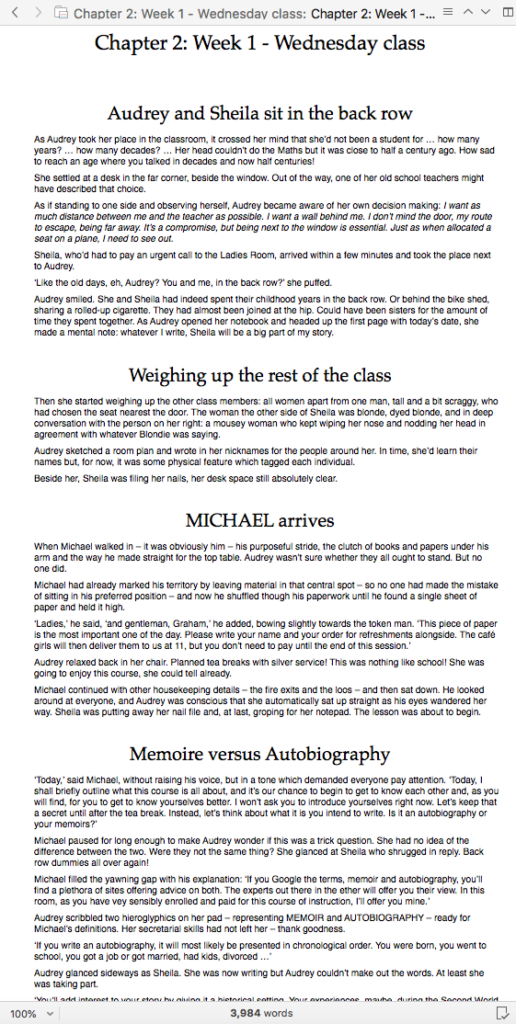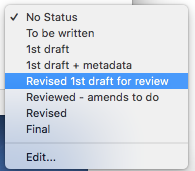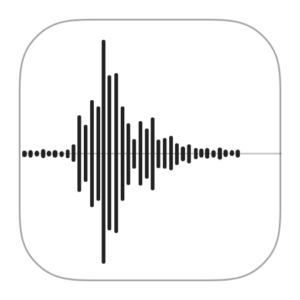
First draft editing: Leaving myself messages
Show no one the first draft!
So, I have a first draft and once the initial writing process is complete and I’ve looked at the structure of my novel, and I’m relatively happy with what’s there, then the editing starts for real.
 But, where do I start?
But, where do I start?
Here’s my strategy. It might work for you.
(Obviously, I’m applying my RedPen cycle, and this is Step 4: Study the content.)
Reading the first draft aloud
Working through, one chapter at a time, I read the text aloud from the screen.
- If I spot a typo, I might fix it straight away. (If so, I go back to the paragraph before last and restart reading from there.)
- If I stumble on a phrase, I know I’ll need to fix that part. I don’t attempt to fix it. I just leave myself a message.
- If something dawns on me, like ‘I need to make sure the reader knows this before this point’ or ‘perhaps I should delay this reveal’, again I leave myself a message.
- If I spot an inconsistency, which causes me to worry about my facts, like ‘I thought Audrey’s hair was blonde’, I leave myself a message.
By the time, I’ve finished reading a chapter aloud, there can be quite a few messages to myself, which I will process later.
How do I leave myself messages?
Scrivener offers a range of ways that you can leave yourself (and others, if you are collaborating) messages.
- Annotations
- Footnotes
- Comments
- Notes / Bookmarks
If you are using Scrivener 2, I’ve already written a series of blog posts explaining how to use these various features.
- Collaborative working with Scrivener: Overview
- Messaging in Scrivener: 1 Annotations
- Messaging in Scrivener: 2 Footnotes
- Messaging in Scrivener: 3 Comments
- Messaging in Scrivener: 4 Document notes
- Messaging in Scrivener: 5 Project notes
- Messaging in Scrivener: Overview
If you upgraded to Scrivener 3, like me, or a new to Scrivener but using Scrivener 3, there have been a few changes. In the next few blog posts, I’ll be looking at these changes and how they affect the way I process my own messages to myself.
Reading the first draft and recording it
After the initial reading aloud, I then read each chapter again – but this time I record myself.
It’s not complicated. I use an app on my mobile phone: Voice Memos.
And then, maybe a day later, maybe a week later, maybe a month later, I listen to my recordings, one chapter at a time.
If anything occurs to me, I press pause, locate the relevant point within the manuscript and leave myself a message.
- Check this.
- Check that.
- Needs more dialogue here?
- I said that already?
The Scrivener feature that I use – annotation, or comment, or footnote, note or bookmark – depends on the message I leave. I’ll explain that too in subsequent posts!
Asking someone else to read your first draft aloud?
 I usually delay showing my work to others until I have completed the first round of edits, so it’s no longer the first draft.
I usually delay showing my work to others until I have completed the first round of edits, so it’s no longer the first draft.
We could call it draft 2. I use the Label field and call it ‘Revised 1st draft for review’.
Questions? Need a helping hand? Want a demo?
To watch me go through the process of leaving myself messages using the various Scrivener features or to ask any questions, book a Simply Scrivener Special.
To help me to prepare, you could also complete this short questionnaire.
The ScrivenerVirgin blog is a journey of discovery:
a step-by-step exploration of how Scrivener can change how a writer writes.
To subscribe to this blog, click here.
Also … check out the Scrivener Tips
on my ScrivenerVirgin Facebook page.




KT Shannen
4 June 2018 at 19:22Thank you so much for the help, Anne. I was just trying to figure out what to do next since I’ve just started my first draft edits. Very timely! 🙂
Anne Rainbow
11 June 2018 at 10:22I’m chugging along too, so each post should mirror what you need to think aboout next!
And, you could come to the weekly Simply Scrivener Specials, and ask away …